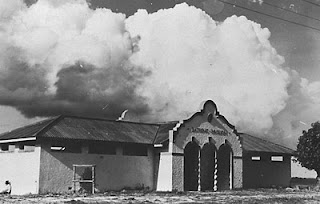
In the 1920s Southport was place to be for the leading lights of Queensland's capital, Brisbane to come for a seaside dip.
It in fact had been since the 1880s when the railway made the 70km journey more palatable. Indeed, Queensland's Governor had a house in Southport.
So popular was the town of Southport, proving to be a 'hot spot' for property investors that they flocked to Brisbane to bid on parcels of land for sale in the uninspiringly (but accurately) named Railway Station Estate, when living near the railway was seen as a winning feature (except on wash days).
 But in the early 1930s it was point out that a lack of, ahem, shall we say 'conveniences' was hampering Southport's reputation as a top holiday spot:
But in the early 1930s it was point out that a lack of, ahem, shall we say 'conveniences' was hampering Southport's reputation as a top holiday spot:The development of the Esplanade included tree-planting schemes, the addition of various side-show amusements and the construction of a picture theatre on the Southport Pier.The first picture is the pavilion as it stands today, on the Broadwater side of Marine Parade between Nind and Railway Streets.
It was as part of the scheme of beautification at Southport that two bathing pavilions were erected, one on Main Beach and the other smaller building, the Southport Bathing Pavilion on the Esplanade (pictured) close to the railway station. The two buildings were opened on the 20th December, 1934 by the Minister for Works, Mr H.A. Bruce.
During a speech at the ceremony, mention was made of Southport being primarily dependant on visitors, and if something was not done for their comfort and convenience (Southport) would lose them. A newspaper report described the design of the buildings as Spanish.
Instead of being swamped by bathers, this lovely building is marooned in a park with the busy four lane Marine Parade at its front door and 400 metres of grassed park to its rear.
 But we know from previous Sunday Drives that it wasn't forever thus.
But we know from previous Sunday Drives that it wasn't forever thus.Sadly time marched on for Southport, subsumed in 1949 as part of the larger South Coast Council, then officially remained The City of the Gold Coast.
Visitors have marched on too, now preferring the rough and tumble of the ocean breakers they find just another five minute's drive away.
The pavilion has stood the test of time well although its new role is equipment storage. But it's been heritage listed and so will always remain in the good care of the Gold Coast City Council.
 And the tree planting scheme mentioned in the article - boy did it work. The large dominating tree is likely to be a Moreton Bay fig - a large and vigorous shade tree.
And the tree planting scheme mentioned in the article - boy did it work. The large dominating tree is likely to be a Moreton Bay fig - a large and vigorous shade tree.How vigorous?
Well, see the little plant protected by the barricades on the left of the front doors?
Well it's not enough to shade the sleeping man seen on the far left edge of the shot, but go back to the contemporary images. In 73 years time, it's big enough to dominate the pavilion itself and robust enough for his great grandchildren to climb.
Now that's history.

No comments:
Post a Comment